The Museum Collections
Introduction
I. History and Art Collection
1. Icons of the 14th 19th centuries
icons of the 14th 17th century
2. Jewelry art of the 14th 20th century
jewelry art of the 14th 17th century
jewelry art of the 18th 19th century
the european silver 14th - 19th centuries
3. Small-size sculptures (works of metal, wood, bone)
XI the beginning of the XX century
Small-size sculptures 11th 17th century
Small-size sculptures 18th early 20th century
enamel of Troitza masters 15-8th early 20th century
5.Embroidery, lace, textiles of the 14th - early 20th century
icon and ornamental embroidery
gold and silver lace
6.Painting of the 18th 21st centuries
painting of the 18th 19th centuris
painting of the 20th 21st centuris
II.Manuscripts and old printed books of the 14th 17th century
IV.Lithography of the 18th 19th century
V.Numismatics
VI.Medals of the 18th - early 20th century
VIII.Archeology collection
IX. Russian folk and applied and decorative art of the 17th 21st c.
1. Artistic wood
folk carved and painted wood
wooden toys
house carving of Sergiev Posad
Khokhloma and Gorodets painting
2. Artistic textiles
embroidery and weaving
printed textiles and lace
Russian shawls
folk costumes
folk garments
printed cotton kerchiefs
|
Printed textiles and lace 17th 20th century
Printed textiles |
Long since in Russia knew a way of an ornament of textiles by means of carved wooden printed boards maners. They became entirely from a wood, the pattern was cut from both parties. In a 17th century printed boards were very massive, the size of each of the board parties sometimes reached 50 cm. The big wooden board smeared with an oil paint, imposed from above the moistened canvas and roll by wooden battledore that the pattern was printed on a textiles. Such textiles was called as a printed textiles. In a 17th century printed textiles thanking their beauty and comparative cheapness were widely applied in a life of Russian people. From a printed textiles not only sewed textiles, but also banners, tents, curtains, church vestments.
Samples of printed textiles of 17th century differ splendour of a vegetative ornament with difficult motives of fantastic colours, decorative leaves and stalks. Ease and grace of flower forms, thin cutting of details are inherent to printed textiles in 18th century. Conditionally the printed textiles ornament can be divided into two kinds. The elementary patterns of printed textiles represent a combination of simple geometrical elements - circles, daggers etc. Sometimes geometrical patterns alternated with vegetative motives - colours, berries, leaves.
|
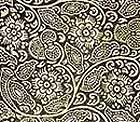
Sample of printed textiles. 17th century. Flax. Printed textiles |

Sample of printed textiles. 18th century. Flax; Printed boards. Wood. Metal |
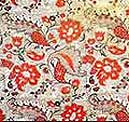
Sample of printed textiles. 18th century. Flax. Printed textiles |
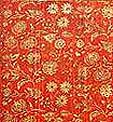
Sample of textiles. 18th century. Flax. Printed textiles |
In a 19th century Russian printed textiles had the further development. Scarves, sundresses, well-known Russian shawls made of printed textiles. Clothes printed with simple small patterns on dark blue cube background (the name from a cube in which planted paint) again. The more favorite colour combination of the country printed textiles in a 19th century was dark blue with white. The printed textiles brought from Kargopolsky district of the Arkhangelsk region ornamented by large white stars and birds. Russian printed textiles of the 19th century widely presented by products of Russian North.
|
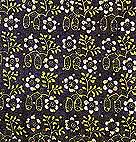
The sample of printed textiles. 19th century. Arkhangelsk region, river Lizen. Flax. Printed textiles |
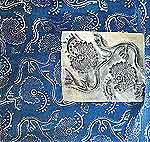
Printed textile and printed board. 19th century |

Calico scarf. End of 19th century. Ivanovo |
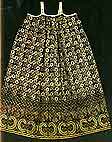
Sundress of the printed textiles. 19th century. Arkhangelsk region. Cubs printed textiles |
Lace
|
Modern lacebraiding develops in the ancient glorified centres - Vologda, Elets, Sovetsk (the former large village of Kukarka), Mihaylov, Kirishi. Difficult and beautiful lacy patterns weave by manually bobbins in each of them with a traditional manner. The most decorative is the Vologda lace. The large thick pattern comes to light here a dense coiling white band. Large vegetative motives, sockets, ๒๐่๋่๑๒ํ่๊่, forming the most various compositions, appear on an easy grid of a background. The Elets lace differs by the big grace and ease. Strict simplicity of a pattern of the Kirov lace is it in common with Vologda one, and on ease and a subtlety of workings out it is similar to the Elets.
Recently patterns began to be enriched by the background grid sated with ornamental motives. The colour lace of Mihayovsky district of the Ryazan region differs not only by the bright decorative effect, but also other technics of weaving. In finished articles the lace is combined with the Ryazan embroidery or pattern weaving. The particular interest represents a thin lace, ๘่๒๎ๅ a needle. It is made in the city of Kadome of the Ryazan region. A background diamond-shaped geometrical figures with sockets, asterisks, circles accurately appear on a small openwork of grid. These patterns led round by white threads and filled with small darning are perceived by a gentle white silhouette. The thin parity easy openwork a background to more dense white pattern gives to a lace special lightness and grace.
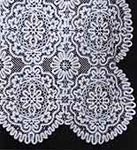
V.D.Veselova (Indisheva). Coverlet. 1954. Fragment. Vologda lacy artel. Vologda |
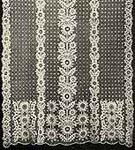
N.P.Davidov (Shreider). Curtain. 1951. Fragment. Elets industrial union of lace makers. Elets, Lipetsk region |
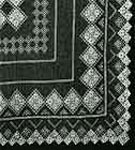
E.V.Shembakova. 1958. Fragment. Kadomsk lacy artel "Awakening". Kadom. Ryazan region |
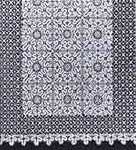
A.A.Guzhavina. Coverlet "Circles". 1956. Fragment. The Soviet lacy artel of Sovetsk. Kirov region |
| |


